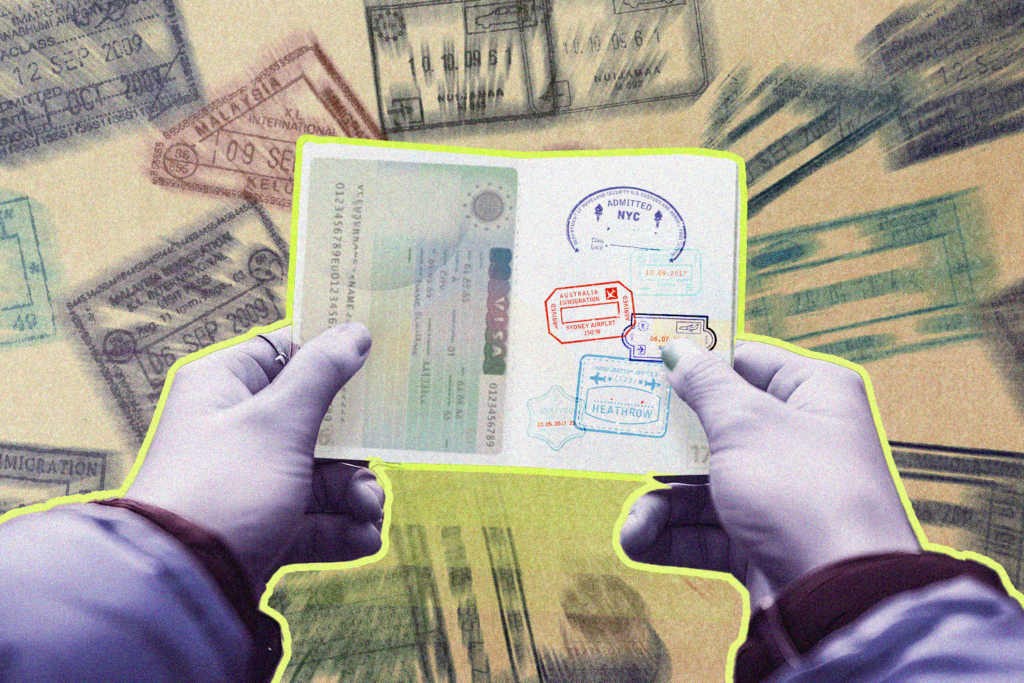
[ad_1]
Five years ago, Indian newlyweds Pallabi and Kshitiz were all set for their dream honeymoon in Australia. But Kshitiz had a business trip to Dubai that left him with no time to submit his passport for the Australian visa, which would take about a month to process. They had to settle for a local getaway instead. Fast forward to today, and with Australia’s new online visa application process — no passport submission required — they’re finally heading to Australia this October.
Rahul Diwan has a visa-disappointment story too. In 2018, right after he started his MBA in Dublin, he had a shot to study for a semester at Yale University in the U.S. But Ireland required a re-entry visa for Indian passport holders, and with a month-long wait, it just wasn’t possible.
Stories of visa headaches are all too common for travelers throughout Asia. It’s been a major block on growth in tourism. But there are subtle yet significant changes happening that highlight a broader trend: In many countries, the walls are coming down and the world is slowly opening up, despite increased tensions and a movement in some areas toward isolationism.
Digital platforms have replaced the cumbersome paper applications, offering quicker, more efficient processing. Some countries have introduced more flexible visa categories and expedited services, while other nations have implemented visa waiver programs or eased entry requirements.
According to the UN Tourism’s Tourism Visa Openness Report, the need for traditional paper visas has dropped significantly. In 2023, only 47% of travelers required a paper visa, down from 59% in 2018 and a striking 77% in 2008.
Also, 18% of the world population can apply for e-visas in 2023, an increase from 7% in 2018 and just 3% in 2013.
This is a boon for travelers, allowing more spontaneous trips. And it’s even more of a windfall for destinations, which can increase tourism and, in turn, boost economies.
Diwan notes that Ireland has dropped its re-entry visa rule for all nationalities. “If only I had the same opportunity now,” he says. “Who knows how different things might’ve been if I had a chance to visit Yale?”
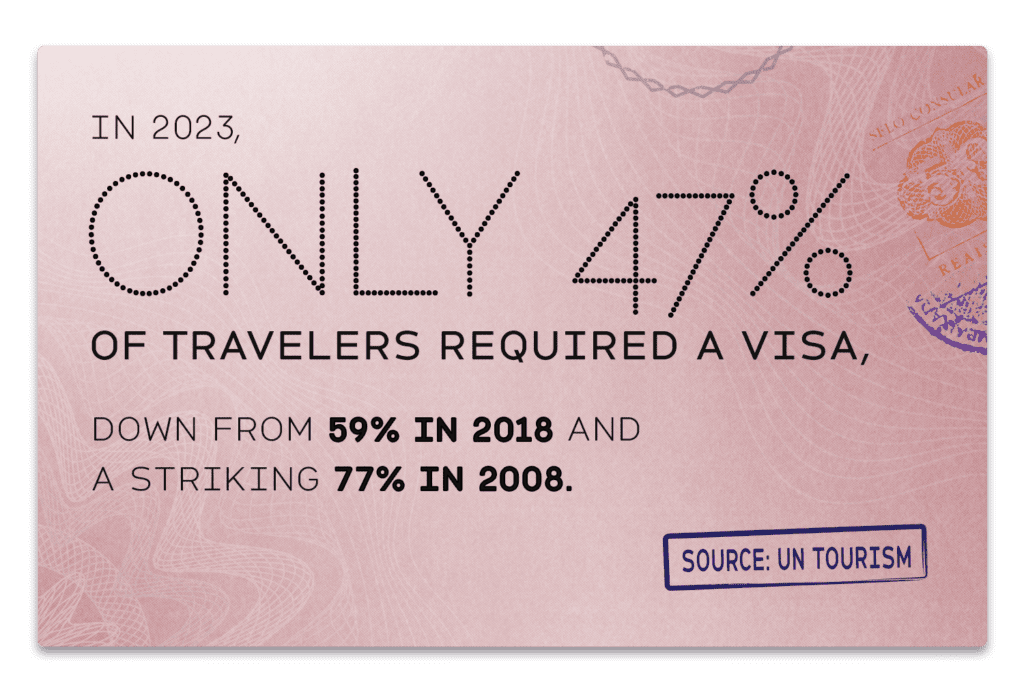

How Visas Evolved and Shaped Global Travel
The concept of visas — formal endorsements on travel documents permitting entry into a country — dates back centuries, though they have evolved significantly.
The first country to introduce the modern visa system is often considered to be France, which introduced entry requirements in 1914 amid the outbreak of World War I. The war heightened global concerns over national security, and many countries followed suit, developing systems to vet foreign visitors and limit the movement of enemy nationals.
After World War I, international travel soon required not just a passport but also official permission from the destination country in the form of a visa.
After World War II, global travel expanded as visa regimes became more liberalized, partly due to diplomatic efforts.
Years later, a key development was the Schengen Agreement (1985) and Schengen Convention (1990), which allowed free movement across European borders and today includes 29 countries. Schengen boosts trade, migration, and tourism, facilitating 1.25 billion trips annually, according to a research paper by global hospitality services company HVS and Israel’s Abraham Accords Peace Institute Analysis.
Visa Rules Are Loosening Worldwide — And Tourism Is Soaring
Countries are catching on to this potential.
Inspired by the benefits of Schengen, the Gulf Cooperation Council of six Arab countries plans to introduce a unified visa by next year, and Thailand is proposing a similar plan for Southeast Asia.
Throughout the year, Skift has documented the relaxation of rules throughout Asia.
Sri Lanka is the latest example. The island nation is launching a six-month pilot program starting October 1, offering free 30-day tourist visas on arrival to citizens from 35 countries, including India, the U.S., and China. Timed with the peak travel season, this initiative is part of Sri Lanka’s strategy to rejuvenate its tourism industry. It aims to draw in 2.5 million visitors and generate $4 billion in revenue by the end of the year.
Malaysia introduced a visa-free policy for Chinese and Indian tourists in December 2023. The country’s arrivals figures for the first 6 months of this year touched almost 2 million for Indian and Chinese tourists, an increase of more than 150% over the same period last year.
At a press conference last December, Riad Asmat, CEO of AirAsia Malaysia, called the new policy “one of the highlights of the year” for the airline. Starting November 16, AirAsia will launch thrice-weekly flights connecting Port Blair in India to Malaysia, expanding its Indian destinations to 17. The airline now operates 91 flights weekly to India and has added eight new routes in 2024 alone.
Vietnam witnessed a 58.4% increase in tourist arrivals in early 2024 after announcing e-visas for all nationalities.
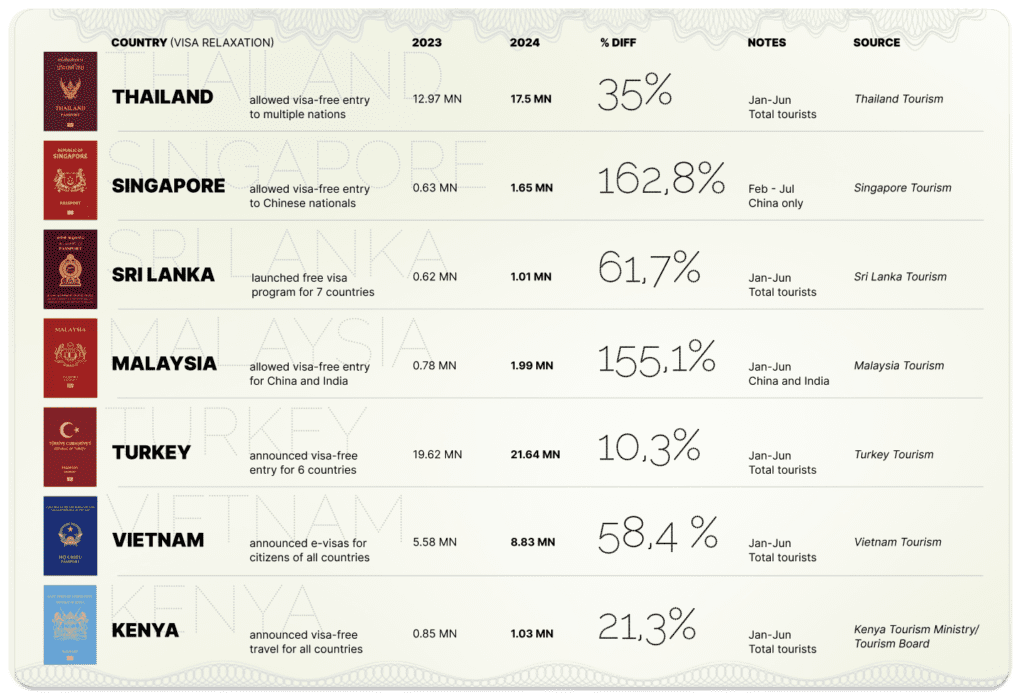

After unveiling its ambitious tourism goals for 2030, Saudi Arabia made easing entry requirements a priority. The country introduced a stopover program that grants a 96-hour free visa to travelers flying with Saudi Arabian Airlines or Flynas. Additionally, those with a U.S., UK, or Schengen visa can now get an e-visa or visa on arrival.
Dubai, too, has streamlined entry, offering visa on arrival to holders of U.S., UK, or Schengen visas. The emirate has also launched a five-year multiple entry visa for Indian citizens.
The Haves and the Have-Nots
While the world is gradually reopening for travelers from major tourism source markets, certain regions still face immense hurdles when it comes to securing visas, particularly those from low- and middle-income countries. Visa barriers disproportionately affect those from developing nations despite extensive documentation, sponsorships, and invitations. These restrictions come at a steep cost to these travelers.
A 2018 survey by the research organization RAND revealed that researchers from Africa and Asia face the most significant visa-related obstacles for short-term visits. In 2022, the UK most frequently refused visas to territories in Africa, reflecting a broader trend of uneven visa policies.

The travel industry’s premier annual event.
Sept. 17-19 in New York City
Register Now
How the U.S. Is Addressing Visa Issues
For much of 2022 and 2023, visa wait times for entry into the U.S. remained stuck at over 400 days on average for first-time travelers in some top inbound markets, a hangover from the pandemic.
The State Department has implemented a series of changes like waiving interviews for select applicants, moving staff to countries with large backlogs, and hiring staff back to pre-pandemic levels. In December 2023, the State Department extended its visa interview waiver authority for visa applicants indefinitely.
“We reduced the median global wait time for first-time tourist visa applicants by 70% in just 18 months,” a State Department spokesperson told Skift.
However, the department acknowledged that in a small number of places, including India, wait times are still high.
The department emphasized that longer wait times do not equate to fewer visa approvals, and instead reflect heightened demand. “India is one of our most crucial posts for visa processing,” the spokesperson said, “The U.S. is committed to providing the necessary resources to continue reducing wait times in such high-demand locations.”
“In the first nine months of fiscal 2024 (October 1, 2023–June 30, 2024), globally we issued nearly 8.2 million nonimmigrant visas. That breaks our all-time issuance record for this time period as well as at 30% of our U.S. embassies and consulates overseas,” the spokesperson said.
The State Department said that visa processing in India has seen significant improvements, with interview wait times for first-time business and tourist applicants dropping by 40% in the first half of fiscal 2024. The department also highlighted the record-breaking 1.1 million nonimmigrant visas issued by U.S. Mission India in fiscal 2023, with nearly 880,000 nonimmigrant visas already issued by the nine-month mark this year.
The U.S. Mission in India set a new record by issuing nearly 540,000 B-visas for temporary visitors in the first three quarters of fiscal 2024.
Thailand Eyes Tourism Boom with Visa Push
Thailand is taking steps to revitalize its tourism sector with new visa promotions. The country has expanded its visa-free and visa-on-arrival schemes, allowing visitors from 93 countries to stay visa-free for up to 60 days — double the previous limit. The Thai cabinet has also approved visa-on-arrival for 31 countries.
The Tourism Authority of Thailand (TAT) notes that these measures have already stimulated Thai tourism. “From January 1 to August 29, 2024, we welcomed over 23 million international tourists, with notable growth from several markets following the implementation of these policies,” a TAT spokesperson told Skift.
The mutual visa exemption with China has led to a surge in Chinese tourists, with over 4.7 million recorded year-to-date. Furthermore, the number of tourists from Taiwan and India has reached a historic high, likely due to the visa-free scheme introduced late last year, and now extended until November 11.
TAT is actively leveraging these new visa policies. “We are working with airlines to increase seat capacity by expanding existing routes and establishing new ones for both regular and charter flights,” the spokesperson said. This strategy will ensure more accessible access to Thailand from key markets worldwide.
In addition to these initiatives, TAT aims to spread travel patterns evenly throughout the year to reduce seasonal pressures. For example, during the green season, Thailand will host festivals and events, including the Loi Krathong Festival and the Amazing Thailand Marathon Bangkok in December.
Thailand will be inching closer to its 2019 high of 40 million foreign visitors this year with hopes to surpass the number by next year.
China’s Travel Surge: Visa Eases Fuel Global and Inbound Tourism Boom
Destinations around the world had hoped for a strong rebound in tourism from China after the pandemic, but it has been slow to come. The countries that are doing best at attracting Chinese tourists are those that have made concessions on visas.
During the recent Chinese New Year, 3.6 million Chinese travelers headed abroad, favoring destinations like the UAE, Thailand, Malaysia, and Morocco — countries with relaxed visa rules. Thailand, in particular, saw a noticeable uptick in Chinese tourists during this period, a direct result of its eased visa requirements. Singapore also reported a 163% increase in Chinese tourists from February to July after granting visa-free entry for Chinese nationals.
In its earnings call last month, Trip.com CEO and Director Jane Sun, spoke about long-haul destinations gaining popularity once again, and credited improved visa processing as one of the reasons for fueling this trend.
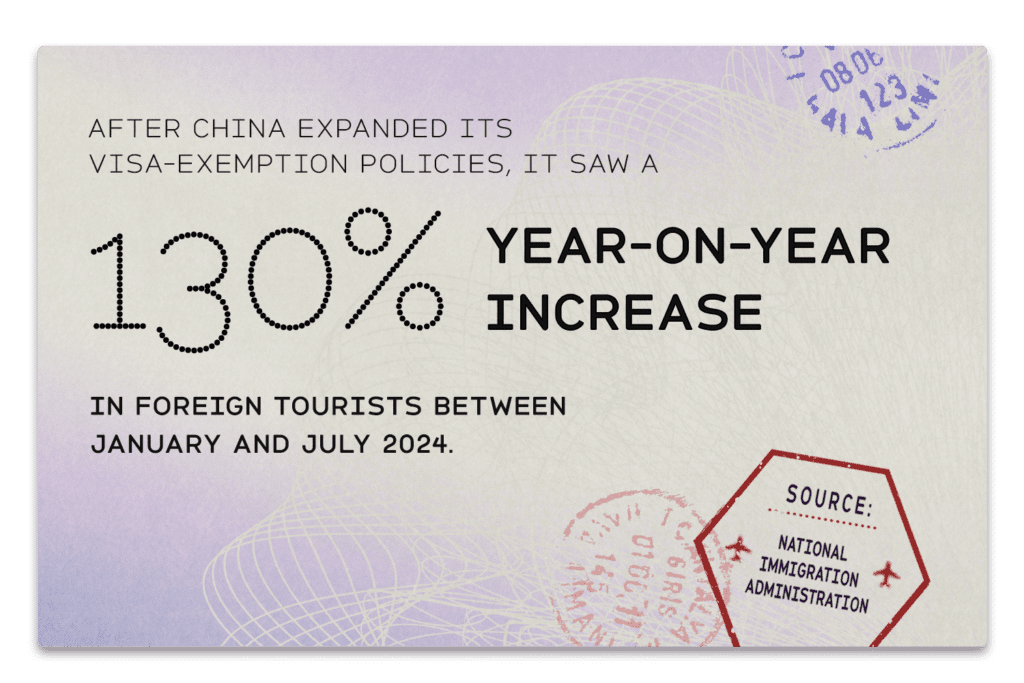

“Bookings surged to more than 120% of 2019 levels during the May labor day holiday and over 110% during Dragon Boat Festival. The APAC region was the top choice for Chinese travelers, with visa-free destinations such as Singapore, Thailand, and Malaysia seeing a strong resurgence,” Sun said.
Boon Sian Chai, managing director and vice president of international markets for Trip.com, noted that simplified entry rules for Chinese travelers could have widespread benefits for global tourism. Speaking at the Skift Global Forum East in Dubai last year, he pointed out that China’s outbound travel has been limited by flight capacity and visa hurdles.
China is also experiencing a surge in inbound tourism as a result of its own relaxed entry policies. Between January and July 2024, 17.25 million foreign tourists visited China, marking a 130% increase from 2023. The expansion of China’s 144-hour visa-free transit policy and new regional visa exemptions are fueling this growth.
On inbound travel to China, Sun noted during the earnings call that visitors from visa-free countries have surged by 190% over the same period in the April-June quarter.
India’s Outbound Tourism Soar as Visa Policies Fuel Global Travel Boom
India is emerging as a key player in outbound tourism with annual growth of 11%. Limited visa restrictions have significantly boosted travel bookings to nearby destinations. In 2017, Indian travelers had visa-free access to 49 countries – by the end of 2023 it had risen to 60, according to the Henley Passport Index.
“Our data indicates increased interest in countries with visa-free, easy visa, and e-visa options, such as Thailand, Malaysia, Indonesia, Azerbaijan, Mauritius, Maldives, Bhutan, Nepal, and Fiji,” said Rajeev Kale, president and country head, Holidays, MICE, Visa at Thomas Cook (India).
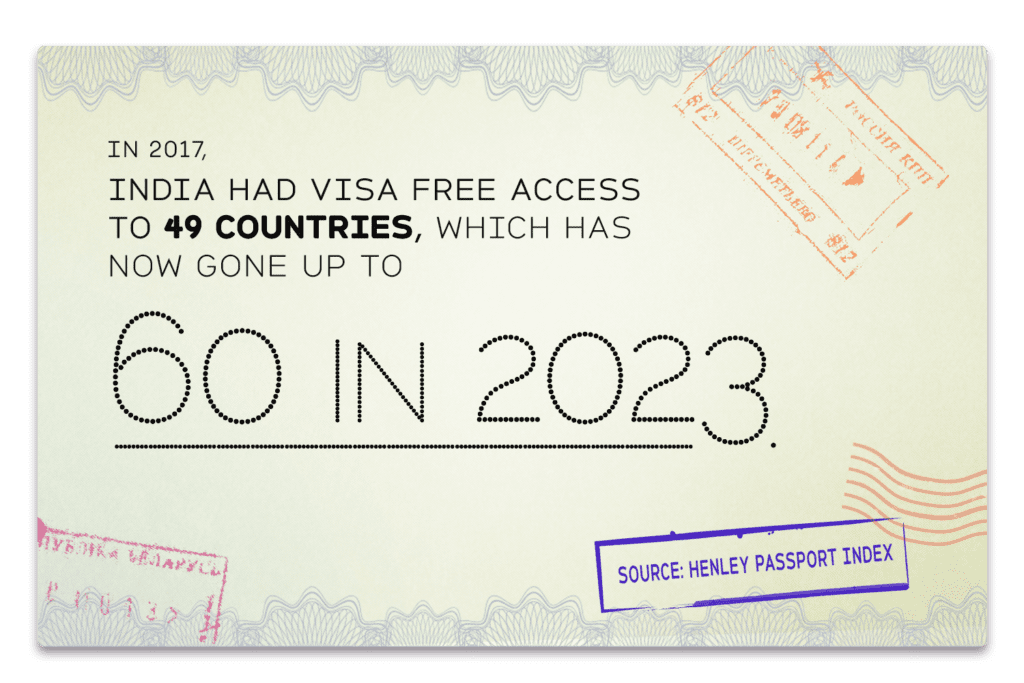

Travelers are now leaning toward short getaways, like weekend trips, due to the ease of obtaining visas. “This shift has led to a rise in ‘minication’ or brief, frequent escapes. Young working professionals and last-minute planners are key demographics for these minications,” Kale explained.
Indian online travel agencies (OTAs) are capitalizing on visa-free travel to further boost the industry. “Recent changes in visa policies have further fueled this growth, as countries like Malaysia, Thailand, Sri Lanka, and Kenya have waived visa requirements for Indian citizens.” said Ixigo in the prospectus for its June IPO.
With a new generation of Indian travelers willing to spend up to $7,000 on international trips, countries are eager to tap into this lucrative market. Thailand’s decision to allow visa-free entry for Indian nationals last year resulted in a 28% increase in searches for trips to Thailand on Agoda. Similarly, Sri Lanka’s decision to waive visas for Indian travelers led to a significant tourism boost, with Indian visitors more than doubling in January 2024 compared to the previous year.
MakeMyTrip co-founder and group CEO Rajesh Magow highlighted this trend during an April earnings call. “Countries in Southeast Asia, the Middle East, and even parts of Europe are opening up their visa operations to woo Indian tourists. There is a significant opportunity for growth,” he said.
This success has also prompted countries like Indonesia, Russia, Japan, and South Africa to consider easing their visa restrictions for Indian travelers.
The relaxation of visa rules is also impacting the wedding industry. Vikramjit Singh Oberoi, CEO and MD of Oberoi Hotels, noted that the number of weddings hosted by the hotel chain declined in 2023 compared to 2022.
“One reason could be that people are now looking at destinations outside India for their weddings,” he said. “Earlier, it wasn’t possible to host large weddings abroad due to visa restrictions. Those barriers are now gone.”

The travel industry’s premier annual event.
Sept. 17-19 in New York City
Register Now
[ad_2]